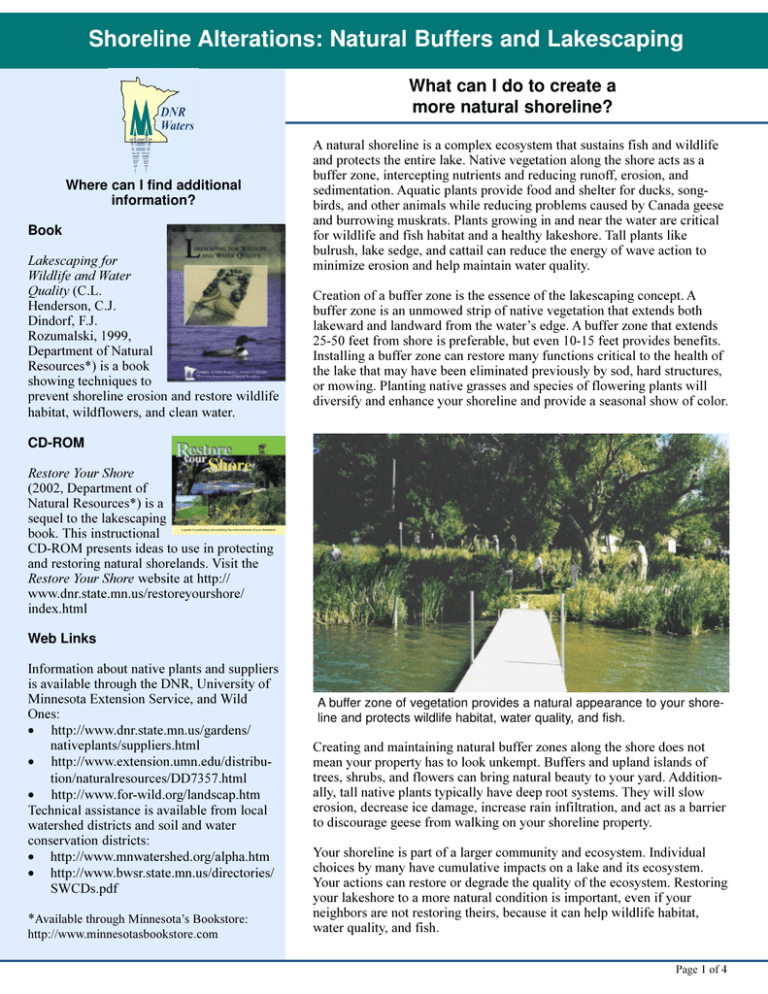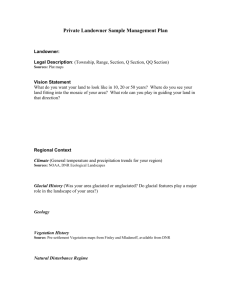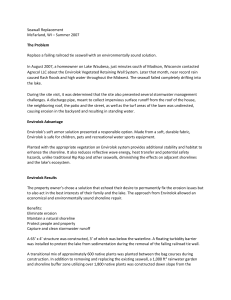Shoreline Alterations: Natural Buffers and Lakescaping more natural shoreline?
advertisement

Shoreline Alterations: Natural Buffers and Lakescaping What can I do to create a more natural shoreline? Where can I find additional information? Book Lakescaping for Wildlife and Water Quality (C.L. Henderson, C.J. Dindorf, F.J. Rozumalski, 1999, Department of Natural Resources*) is a book showing techniques to prevent shoreline erosion and restore wildlife habitat, wildflowers, and clean water. A natural shoreline is a complex ecosystem that sustains fish and wildlife and protects the entire lake. Native vegetation along the shore acts as a buffer zone, intercepting nutrients and reducing runoff, erosion, and sedimentation. Aquatic plants provide food and shelter for ducks, songbirds, and other animals while reducing problems caused by Canada geese and burrowing muskrats. Plants growing in and near the water are critical for wildlife and fish habitat and a healthy lakeshore. Tall plants like bulrush, lake sedge, and cattail can reduce the energy of wave action to minimize erosion and help maintain water quality. Creation of a buffer zone is the essence of the lakescaping concept. A buffer zone is an unmowed strip of native vegetation that extends both lakeward and landward from the waters edge. A buffer zone that extends 25-50 feet from shore is preferable, but even 10-15 feet provides benefits. Installing a buffer zone can restore many functions critical to the health of the lake that may have been eliminated previously by sod, hard structures, or mowing. Planting native grasses and species of flowering plants will diversify and enhance your shoreline and provide a seasonal show of color. CD-ROM Restore Your Shore (2002, Department of Natural Resources*) is a sequel to the lakescaping book. This instructional CD-ROM presents ideas to use in protecting and restoring natural shorelands. Visit the Restore Your Shore website at http:// www.dnr.state.mn.us/restoreyourshore/ index.html Web Links Information about native plants and suppliers is available through the DNR, University of Minnesota Extension Service, and Wild Ones: · http://www.dnr.state.mn.us/gardens/ nativeplants/suppliers.html · http://www.extension.umn.edu/distribution/naturalresources/DD7357.html · http://www.for-wild.org/landscap.htm Technical assistance is available from local watershed districts and soil and water conservation districts: · http://www.mnwatershed.org/alpha.htm · http://www.bwsr.state.mn.us/directories/ SWCDs.pdf *Available through Minnesotas Bookstore: http://www.minnesotasbookstore.com A buffer zone of vegetation provides a natural appearance to your shoreline and protects wildlife habitat, water quality, and fish. Creating and maintaining natural buffer zones along the shore does not mean your property has to look unkempt. Buffers and upland islands of trees, shrubs, and flowers can bring natural beauty to your yard. Additionally, tall native plants typically have deep root systems. They will slow erosion, decrease ice damage, increase rain infiltration, and act as a barrier to discourage geese from walking on your shoreline property. Your shoreline is part of a larger community and ecosystem. Individual choices by many have cumulative impacts on a lake and its ecosystem. Your actions can restore or degrade the quality of the ecosystem. Restoring your lakeshore to a more natural condition is important, even if your neighbors are not restoring theirs, because it can help wildlife habitat, water quality, and fish. Page 1 of 4 Shoreline Alterations: Natural Buffers and Lakescaping Lakescaping and Erosion Control Vegetation is extremely important for controlling erosion. Native trees, shrubs, and grasses dissipate the energy of raindrops, slow the water, and allow it to infiltrate the soil. The DNR and your county soil and water conservation district can help you select the right plants for your project. Listed below are some other erosion-control recommendations. · Prevent erosion. Preventing erosion by maintaining native vegetation is less costly than fixing an eroded area. Think root systems. Native plants typically have greater rooting depth and root density. For example, the roots of the little bluestem (Schyzachyrium scoparium) are about 2-3 feet long and have a great capacity to hold soil. In contrast, the roots of lawn grass are only 2-3 inches long. · Identify and address the cause of erosion. Causes may include excessive foot traffic on fragile soils, vegetation clearing (both upland and in the lake), yard waste on the bank that kills vegetation, wave action from boat traffic and prevailing winds (especially when water is high), ice heaves, stairways that channel water, and runoff from hard surfaces. · Choose erosion-control methods that are light on the landscape. If wave action is eroding the bottom (toe) of the bank, consider reinforcing only the toe of the bank and planting native vegetation on the remainder. · Plant aquatic vegetation. In-lake vegetation can help prevent erosion. Native aquatic vegetation disperses wave energy, anchors soil, limits ice heaves, and provides excellent fish and wildlife habitat. Contrast the eroded shoreline lacking vegetation (foreground) with the well-vegetated, uneroded shoreline in the distance. Lakescaping Design Factors to Consider Look around your lake and note how nature works to minimize erosion on healthy, more natural shorelines. What types of wildflowers, grasses, trees, and shrubs do you see in your area? Then determine how much of your lakeshore to naturalize, keeping in mind how much you need for lake access, swimming areas, docks, and dock storage areas. Talk to your neighbors, share ideas, and coordinate efforts to increase habitat and natural shorelines. Natural shorelines are gaining acceptance as people understand the important role shorelines play in protecting their lake and a diverse ecosystem. Many lake associations are developing demonstration projects on area lakes. Steps for Creating a Buffer Zone Describe your shoreline area, including the following elements: · · · Steve Adams · The picture contrasts the shallow (2-3 inches) roots of Kentucky bluegrass to the deep (3-5 feet) and dense roots of native grasses. The root systems of native grasses may be effective for preventing erosion. · · · natural features, including existing vegetation and woody debris, fish and wildlife use, and opportunities for links to neighboring habitat; removal of structures or construction debris, such as retaining walls or concrete, respectively; location of the house, views, trees, pathways or stairways, docks, and swimming areas; sun, including amount and number of hours of direct sunlight; topography, including ice ridges and slopes (facing directions and steepness); soil characteristics, including type, drainage, texture, and fertility; and water, such as natural seeps, wet areas during high water, drainage, wave action, and runoff. Page 2 of 4 Shoreline Alterations: Natural Buffers and Lakescaping Think about your preferences. How will the site be used (viewing, swimming, boating, fishing)? What kinds of native trees, shrubs, flowers, and grasses do you like? Consider their color, height, and appearances at different times of the year. The type of vegetation you select may affect the shorelines ability to withstand erosion. Leilani Peterson Develop a design and management plan based on your lakeshore and preferences. Consult references and DNR Fisheries lake surveys for information, and visit nearby natural areas or other shorelines to get ideas. Obtain any necessary permits from your local unit of government or the DNR. Be realistic about the size of your shoreline project. Start small, if necessary, and add to it in phases. Planting It may be necessary to eradicate nonnative, invasive species and turf grass first. Remember that collecting, transplanting, or removing aquatic vegetation requires a permit from the DNR Fisheries Aquatic Plant Management Program. break wave action, which helps prevent erosion, and stabilize bottom sediments, which otherwise can be resuspended by currents and wave action. Plants growing on upland slopes and lake banks help keep the lake water clean by holding sediments in place against the eroding forces of water runoff and by absorbing excess nutrients like phosphorous and nitrogen. Adapted by Jean Miller, DNR Leilani Peterson Identify the areas for planting native vegetation and prepare the site for planting. Upland plants should be spaced from 1 foot to 3 feet apart; trees and shrubs should be 6 feet to 14 feet apart. If you decide to use an erosion-control blanket, the supplier can help you determine which type to use. After installing the blanket, simply cut a hole in it for each plant. As (TOP) Lakefront of home on Lake Marion, Dakota County. (BOTTOM) Closer view an alternative to the blanket, mulch of the same lakefront after revegetation. could be used to control erosion, retain moisture, and suppress weeds. Maintenance If you add aquatic plants, a temporary barrier in the water may be needed to protect new plants until they are estabYour new plantings require some maintenance in the first lished. For guidance on aquatic plantings and permit refew years as they become established. Provide from 1 inch quirements, contact the DNR Shoreland Habitat Coordinator to 2 inches of water per week the first season and during dry (651-296-2548) or local soil and water conservation district. periods in the second season. Weeding during the first few years helps the plants become established and gives them a competitive edge. Replace vegetation that did not survive by replanting species that were most successful at your site. By the third year, watering is no longer necessary, but Submergent and emergent you should continue to plants provide underwater cover for fish, amphibremove weeds. ians, birds, insects, and other organisms. These plants Page 3 of 4 Bill Bartodziej Bill Bartodziej Shoreline Alterations: Natural Buffers and Lakescaping (ABOVE) In 2000, start of restoration along Lake Phalen in St. Paul. (RIGHT) View of the same site in 2002. Summary For most projects constructed below the ordinary high-water level* (OHWL) of public waters as determined by the DNR, an individual Public Waters Work Permit is required, but an individual permit is not required for planting buffer zones. Collecting, transplanting, or removing aquatic vegetation, however, does require a permit from the DNR Fisheries Aquatic Plant Management Program. Maintaining a healthy lake is far less costly than trying to fix a degraded one. If you are fortunate enough to have a natural shoreline, maintain or enhance it as a buffer zone and minimize erosion on the areas used for access or recreation. If your property lacks natural areas, plant native vegetation or let areas grow naturally. You will be surprised at the aesthetic appeal, as well as the energy and time you save, of helping your lake help itself. If you have questions concerning the contents of this information sheet, contact your local DNR Area Hydrologist. Other governmental units (federal, state, city, county, township, and watershed authority) may require a permit for that portion of the project within their jurisdiction, which usually involves work above the OHWL. It is advisable to contact them. Carrol Henderson Permit Requirements *For lakes and wetlands, the OHWL is the highest elevation that has been maintained as to leave evidence on the landscape. It is commonly that point where the natural vegetation changes from predominantly aquatic to predominantly terrestrial. For watercourses, the OHWL is the top of the bank of the channel. For reservoirs and flowages, the OHWL is the operating elevation of the normal summer pool. DNR Contact Information DNR Information Center DNR Waters website lists Area Hydrologists: www.dnr.state.mn.us/ waters DNR Waters in St. Paul: 500 Lafayette Road, St. Paul, MN 551554032, (651) 296-4800 Twin Cities: (651) 296-6157 Minnesota toll free: 1-888-646-6367 Telecommunication device for the deaf (TDD): (651) 296-5484 TDD toll free: 1-800-657-3929 DNR Ecological Services website provides information about aquatic plant management permits: www.dnr.state.mn.us/ ecological_services DNR Ecological Services in St. Paul: 500 Lafayette Road, Box 25, St. Paul, MN 55155, (651) 296-2835 This information is available in an alternative format on request. Equal opportunity to participate in and benefit from programs of the Minnesota Department of Natural Resources is available regardless of race, color, national origin, sex, sexual orientation, marital status, status with regard to public assistance, age, or disability. Discrimination inquiries should be sent to Minnesota DNR, 500 Lafayette Road, St. Paul, MN 55155-4031; or the Equal Opportunity Office, Department of the Interior, Washington, DC 20240. DNR Shoreland Habitat Coordinator in St. Paul: 500 Lafayette Road, Box 12, St. Paul, MN 55155, (651) 296-2548 Page 4 of 4


